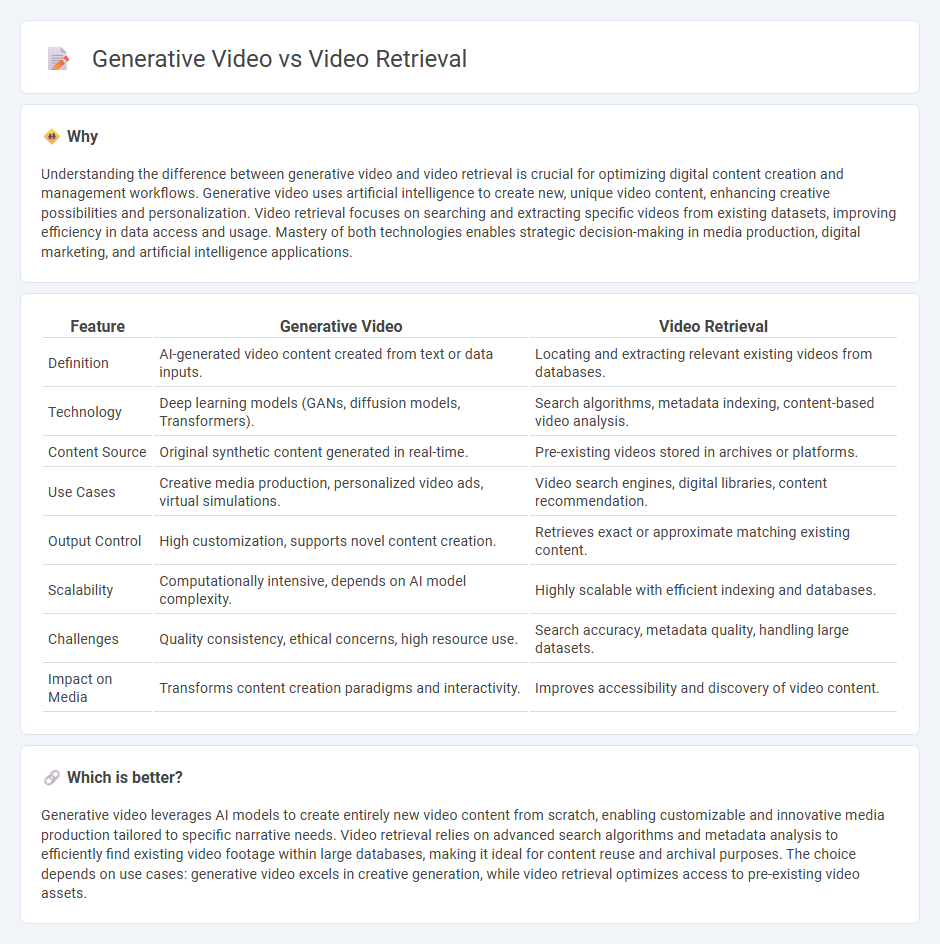
Generative video technology creates new visual content by leveraging deep learning models such as GANs and transformers, enabling the synthesis of realistic scenes from minimal input data. Video retrieval focuses on efficiently searching and indexing existing video databases using semantic analysis and feature extraction techniques like CNNs and attention mechanisms. Explore the latest advancements to understand how these technologies are shaping the future of digital media.
Why it is important
Understanding the difference between generative video and video retrieval is crucial for optimizing digital content creation and management workflows. Generative video uses artificial intelligence to create new, unique video content, enhancing creative possibilities and personalization. Video retrieval focuses on searching and extracting specific videos from existing datasets, improving efficiency in data access and usage. Mastery of both technologies enables strategic decision-making in media production, digital marketing, and artificial intelligence applications.
Comparison Table
| Feature | Generative Video | Video Retrieval |
|---|---|---|
| Definition | AI-generated video content created from text or data inputs. | Locating and extracting relevant existing videos from databases. |
| Technology | Deep learning models (GANs, diffusion models, Transformers). | Search algorithms, metadata indexing, content-based video analysis. |
| Content Source | Original synthetic content generated in real-time. | Pre-existing videos stored in archives or platforms. |
| Use Cases | Creative media production, personalized video ads, virtual simulations. | Video search engines, digital libraries, content recommendation. |
| Output Control | High customization, supports novel content creation. | Retrieves exact or approximate matching existing content. |
| Scalability | Computationally intensive, depends on AI model complexity. | Highly scalable with efficient indexing and databases. |
| Challenges | Quality consistency, ethical concerns, high resource use. | Search accuracy, metadata quality, handling large datasets. |
| Impact on Media | Transforms content creation paradigms and interactivity. | Improves accessibility and discovery of video content. |
Which is better?
Generative video leverages AI models to create entirely new video content from scratch, enabling customizable and innovative media production tailored to specific narrative needs. Video retrieval relies on advanced search algorithms and metadata analysis to efficiently find existing video footage within large databases, making it ideal for content reuse and archival purposes. The choice depends on use cases: generative video excels in creative generation, while video retrieval optimizes access to pre-existing video assets.
Connection
Generative video technology creates new video content using AI models trained on vast datasets, enhancing creative capabilities and personalized media production. Video retrieval systems utilize AI to efficiently search and index large video databases based on content, context, and metadata, enabling quick access to relevant footage. The connection lies in their shared reliance on advanced machine learning algorithms that analyze and interpret visual data, driving innovations in content creation and search functionalities.
Key Terms
Indexing
Video retrieval relies heavily on efficient indexing methods such as keyframe extraction, metadata tagging, and content-based image retrieval to enable fast and accurate search within large video datasets. Generative video techniques, on the other hand, focus on creating new video content through deep learning models that understand temporal dynamics and scene context, often requiring specialized indexing to manage generated assets. Explore the latest advancements in video indexing to discover how these methods transform video accessibility and creation.
Synthesis
Video retrieval relies on indexing and searching vast databases to find pre-existing clips matching user queries, ensuring quick access to relevant content. Generative video synthesis uses advanced AI models, such as GANs and diffusion algorithms, to create entirely new video sequences from textual or visual prompts, enabling limitless creativity and customization. Explore how these cutting-edge technologies revolutionize video content creation and discovery.
Query
Video retrieval leverages pre-existing video databases, matching user queries to indexed metadata and visual features for efficient content discovery. Generative video synthesizes new video content based on textual or visual prompts, enabling dynamic creation rather than static search. Explore the nuances of query processing in both approaches to optimize video understanding and user engagement.
Source and External Links
Video Retrieval | Papers With Code - Video retrieval is the task of selecting, from a pool of candidate videos, the video that best matches a given text query, typically returning results as a ranked list scored by document retrieval metrics.
Composed Video Retrieval via Enriched Context and Discriminative Embeddings - Composed video retrieval (CoVR) integrates modification text with visual queries to enable more sophisticated video search, leveraging both detailed language descriptions and multimodal embeddings for accurate target video retrieval.
Video-Text Retrieval | Papers With Code - Video-text retrieval requires joint understanding of video and language content, differentiating it from standard video retrieval by focusing on bidirectional matching between videos and textual descriptions.
 dowidth.com
dowidth.com